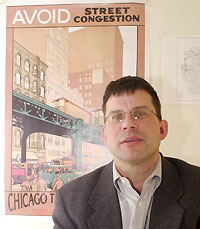|
This is an archived article.
For the latest news, go to the
Advance Homepage
For more archives, go to the Advance Archive/Search Page. | ||
|
History Professor Sheds Light America in the early 19th century was far from a 24-7 society. A lack of adequate outdoor lighting, even in cities, kept most people indoors after dark. The streets belonged to thugs and drunks and nightwalkers, the euphemism for prostitutes. And there were psychological fears as well. Physicians and folklore warned about the harmful effects of nocturnal vapors arising from plants, soil, and stagnant water. This "bad air" caused many people to keep their windows closed, even on the hottest of evenings.
The societal evolution from daylight only to 'round the clock' has long fascinated Peter C. Baldwin, assistant professor of history, who joined the UConn faculty in 2001 from DePaul University in Chicago. He is currently working on a book about the subject, with the provisional title of "American Night, a Social History of the Origins of the 24-Hour City, 1800-1930." "If you go way back to the 18th century, or even the early 19th, being up at night has a kind of unsavory quality." Baldwin says. "There was a lack of lighting and nobody went out. The two kind of reinforced each other." Early streetlamps were dim. "You couldn't actually see anything," Baldwin says. People would follow them much like ships would be guided by lighthouses. "There is not a sudden point at which they switch on the lights and everybody goes out," he says. But gradually, as the lighting improved, more and more people began to venture out after dark. Baldwin, a former reporter for The Hartford Courant, says one of the first clusters of activities was in lower Manhattan, where a handful of New York City's many newspapers were located. Other "pockets of light," as he refers to them, included mills and factories. Public markets began operating in the pre-dawn hours. And there were saloons, lunch wagons, and retail establishments to cater to the growing nighttime work force. "It's not all glamorous," Baldwin says of the trend toward after-dark activities. "Sleeping at night becomes a privilege. People take night shift work not because they enjoy being up, but because they get more money or that's all the work they can get." Baldwin is researching a number of societal changes during this transformation. One concern was the growing number of children working at night in factories, or as newsboys or messengers. "The idea that children and adults should have different daily schedules is a relatively new one," he says. "Over the course of the 19th century, the line is drawn firmly that it's OK for adults to be exposed to this nocturnal environment, but it's not OK for kids." The result was development of child labor laws, curfews, and activities such as Boy's Clubs, to keep children off the streets at night. There were also racial and ethnic tensions to be considered. "This was an incredibly racist time," Baldwin says. "There were discussions about the Chinese as a people who preferred the cover of darkness, of subterranean caves under Chinatown." Jews and African-Americans were also denigrated by derogatory stereotyping. Baldwin, who currently has a fellowship with the University's Humanities Institute, has been working on his project for almost four years, and hopes to finish within the year. His first book, Domesticating the Street, The Reform of Public Space in Hartford, 1850-1930 (Ohio State University Press, 1999), won the Urban History Association's 2000 prize for "Best Book in North American Urban History." "There is stuff about the night in the first book," Baldwin says, "but it's basically about the use of urban space, how it becomes ordered and reordered in the late 19th century, and how certain parts of the city get assigned specific functions." Baldwin was born in New York City, but grew up in Ithaca, N.Y. The book started as his doctoral dissertation at Brown University. So why write about Hartford? Baldwin lived in the city when he worked for the Courant, after graduating from Wesleyan University. "It turned out to be fortuitous," he says, "because Hartford was unusual in the breadth of progressive reform. There was a lot of energy, and lots of organizations were working to make Hartford a better place, in developing the great American city. Historically, he notes, "there were lots of reformers, and fortunately for me, they left lots of records behind. Of course, the problem was when you are trying to publish, nobody really wants to publish a book about Hartford." His current project has a broader scope, looking at the American city more generally. Baldwin says he enjoys being out at night: "I'm not afraid of the dark. In fact, I love walking at night." He notes, however, that it's not a pastime easily accomplished in Storrs, or Lebanon, where he lives, or even, it turned out, in Hartford. "You walk around Hartford at night and the cops will stop you and ask 'What are you doing? Why are you out walking?'" he says. "In Chicago, there are still a lot of people about, even late at night," Baldwin adds. "I enjoy walking then. It's one of the great things about living in a real city." |

